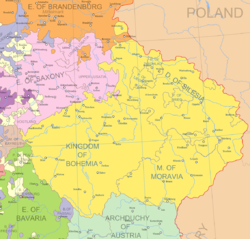Maria Theresa
Maria Theresa (13 May 1717 – 29 November 1780) was the only female ruler of the Habsburg Dynasty of the Holy Roman Empire.
| Maria Theresa | |||||
|---|---|---|---|---|---|
 Portrait by Martin van Meytens, 1759 | |||||
| Holy Roman Empress Queen of Germany | |||||
| 13 September 1745 – 18 August 1765 | |||||
| Archduchess of Austria Queen of Hungary and Croatia | |||||
| 20 October 1740 – 29 November 1780 | |||||
| Coronation | 25 June 1741 | ||||
| Predecessor | Charles III | ||||
| Successor | Joseph II | ||||
| Queen of Bohemia | |||||
| 20 October 1740 – 19 December 1741 | |||||
| Predecessor | Charles II | ||||
| Successor | Charles Albert | ||||
| 12 May 1743 – 29 November 1780 | |||||
| Coronation | 12 May 1743 | ||||
| Predecessor | Charles Albert | ||||
| Successor | Joseph II | ||||
| Born | 13 May 1717 Hofburg Imperial Palace, Vienna, Austria | ||||
| Died | 29 November 1780 (aged 63) Hofburg Palace, Vienna, Austria | ||||
| Burial | Imperial Crypt, Vienna | ||||
| Spouse | |||||
| Issue | See
| ||||
| |||||
| House | Habsburg | ||||
| Father | Charles VI, Holy Roman Emperor | ||||
| Mother | Elisabeth Christine of Brunswick-Wolfenbüttel | ||||
| Religion | Roman Catholicism | ||||
| Signature | |||||
Overview
She reigned as the de facto Empress Regnant of the Holy Roman Empire and Queen of Germany. She was also queen of Hungary and Bohemia, archduchess of Austria, and held many other titles. She changed the royal palace outside Vienna (Austria's capital) to look much like Versailles. Vienna itself became an important center for the arts, especially classical music. Maria Theresa added support to her absolute power by tightening her hold on the government. She also improved conditions for the peasants. She is generally known to history as the Empress Maria Theresa.
Biography
Maria Theresa was born in Vienna, Austria, on 13 May 1717. Her parents were Charles VI, Holy Roman Emperor and Elisabeth Christine of Brunswick-Wolfenbüttel. Her father had made the Pragmatic Sanction of 1713, a decree which allowed a female ruler despite the Salic law's prohibition. Maria Theresa married Duke Francis Stephan I of Lorraine for love. They had sixteen children:
- Archduchess Maria Elisabeth of Austria (1737 – 1740)
- Archduchess Maria Anna of Austria (1738 – 1789)
- Archduchess Maria Carolina of Austria (1740 – 1741)
- Holy Roman Emperor Joseph II (1741 – 1790)
- Archduchess Maria Christina of Austria, Duchess of Teschen (1742 – 1798)
- Archduchess Maria Elisabeth of Austria (1743 – 1808)
- Archduke Charles Joseph of Austria (1745 – 1761)
- Archduchess Maria Amalia of Austria (1746 – 1804)
- Holy Roman Emperor Leopold II (1747 – 1792)
- Archduchess Maria Carolina of Austria (stillborn 1748)
- Archduchess Maria Johanna Gabriela of Austria (1750 – 1762)
- Archduchess Maria Josepha of Austria (1751 – 1767)
- Queen Maria Carolina of Austria of Naples and Sicily (1752 – 1814)
- Queen Marie Antoinette of France and Navarre, born Maria Antonia (1755 – 1793)
- Archduke Maximilian Francis of Austria (1756 – 1801)
Maria Theresa Media
Painting of three-year-old Maria Theresa in the gardens of Hofburg Palace
Archduchess Maria Theresa, by Andreas Möller
Maria Theresa and Francis Stephen at their wedding breakfast, by Martin van Meytens. Charles VI (in the red-plumed hat) is seated at the centre of the table.
Maria Theresa in 1730, by Venetian painter Rosalba Carriera
Maria Theresa's procession through the Graben, a square on Vienna, on 22 November 1740. The pregnant queen is on way to hear High Mass at St. Stephen's Cathedral before receiving homage.[1]
Maria Theresa being crowned Queen Regnant of Hungary, St. Martin's Cathedral, Pressburg
Maria Theresa as the Queen Regnant of Hungary
The Lands of the Bohemian Crown under Habsburg rule until 1742, when most of Silesia was ceded to Prussia
State portrait of Maria Theresa, showing her as the "first lady of Europe" in a dress made of Brabant bobbin lace. On her right are the Hungarian crown of St. Stephen, the Bohemian crown of St. Wenceslas and the Austrian archducal hat as symbols of her power and dignity (painting by Martin van Meytens, c. 1752).
- ↑ Spielman 1993, p. 207.










